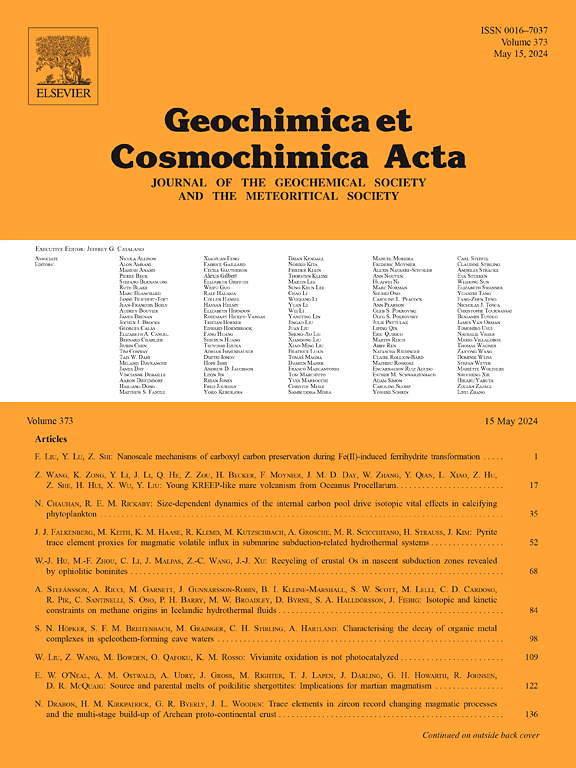基于镁锌同位素的俯冲带碳输入的三维变化
IF 4.5
1区 地球科学
Q1 GEOCHEMISTRY & GEOPHYSICS
引用次数: 0
摘要
俯冲带是地表碳进入地球深部的主要通道。在全球范围内,不同俯冲带的脱碳具有非均匀性。目前尚不清楚的是,在一个俯冲带中,从板块中释放出的碳沿走向的小范围变化。本文给出了与日本海沟平行分布的中新世玄武岩的Mg-Zn同位素数据,这些数据可以与不同的板块脱碳效率联系起来。根据镁锌同位素数据,采样点可分为北部、中部和南部三组。北部样品δ66Zn值高(0.40‰~ 0.62‰),δ26Mg值低(-0.48‰~ -0.37‰)(即存在Mg-Zn同位素组成耦合)。中心样品的δ66Zn值与全球地幔样品的δ66Zn值(0.25‰~ 0.31‰)有重叠,δ26Mg值(-0.35‰~ -0.19‰)略低于正常地幔(即Mg-Zn同位素组成有轻微的解耦)。南部样品δ26Mg值低(-0.56‰~ -0.02‰),δ66Zn值正常(0.26‰~ 0.40‰)(Mg-Zn同位素组成存在解耦)。北部样品的Mg-Zn耦合同位素表明,板源流体中溶解的碳酸盐沉积物有助于弧/弧后火山作用。相比之下,南部样品的Mg-Zn同位素解耦合,这意味着碳酸盐沉积物被保留在板块中,并被运送到地幔楔下的很大深度和很长的距离。这与在相关的板内火山中广泛出现的岩浆岩捕虏体是一致的。这些碳输入的差异对应了板块几何形状和地幔流动动力学导致的板块热结构,即北热南冷。因此,在全球范围内,不同俯冲带的小尺度热结构影响了沿海沟短距离碳输入的空间变化,这可能是深部地幔难以捉摸的地球物理异常和氧化还原非均质性的原因。本文章由计算机程序翻译,如有差异,请以英文原文为准。
Three-dimensional variations in carbon inputs to a subduction zone based on Mg–Zn isotopes
Subduction zones are the main pathways for the transport of surficial carbon into the deep Earth. Heterogeneity of decarbonation was recognized in different subduction zones on a global scale. What is unclear yet is the small-scale along-strike variations in carbon released from slab in a subduction zone. In this paper, we present Mg–Zn isotope data for Miocene basalts distributed parallel to the Japan Trench that can be linked to different slab decarbonation efficiencies. The sampling sites can be divided into three groups based on the Mg–Zn isotope data: northern, central, and southern. The northern samples have high δ66 Zn (0.40 ‰ to 0.62 ‰) and low δ26 Mg (–0.48 ‰ to –0.37 ‰) values (i.e., there is coupling of the Mg–Zn isotopic compositions). The central samples have δ66 Zn values that overlap with those of global MORBs (0.25 ‰ to 0.31 ‰), and they have slightly lower δ26 Mg values (–0.35 ‰ to –0.19 ‰) than normal mantle (i.e., there is slight decoupling of the Mg–Zn isotopic compositions). In contrast, the southern samples have low δ26 Mg (–0.56 ‰ to –0.02 ‰) and normal δ66 Zn values (0.26 ‰ to 0.40 ‰) (i.e., there is decoupling of Mg–Zn isotopic compositions). The northern samples with coupled Mg–Zn isotopes indicate that dissolved carbonate sediment in slab-derived fluids contributes to arc/back-arc volcanism. In contrast, the southern samples have decoupled Mg–Zn isotopes, implying that carbonate sediment is retained in the slab and transported to great depths and long distances beneath the mantle wedge. This is consistent with the widespread occurrence of wehrlite xenoliths within associated intraplate volcanoes. These differences in carbon inputs correspond to the slab thermal structure caused by slab geometry and dynamics of mantle flow, which is hot in the north and cold in the south. Globally, the small-scale thermal structure of different subduction zones therefore affects the spatial variations in carbon input in short-distance along the trench, which are probably responsible for the elusive geophysical anomalies and redox heterogeneities of the deep mantle.
求助全文
通过发布文献求助,成功后即可免费获取论文全文。
去求助
来源期刊

Geochimica et Cosmochimica Acta
地学-地球化学与地球物理
CiteScore
9.60
自引率
14.00%
发文量
437
审稿时长
6 months
期刊介绍:
Geochimica et Cosmochimica Acta publishes research papers in a wide range of subjects in terrestrial geochemistry, meteoritics, and planetary geochemistry. The scope of the journal includes:
1). Physical chemistry of gases, aqueous solutions, glasses, and crystalline solids
2). Igneous and metamorphic petrology
3). Chemical processes in the atmosphere, hydrosphere, biosphere, and lithosphere of the Earth
4). Organic geochemistry
5). Isotope geochemistry
6). Meteoritics and meteorite impacts
7). Lunar science; and
8). Planetary geochemistry.
 求助内容:
求助内容: 应助结果提醒方式:
应助结果提醒方式:


